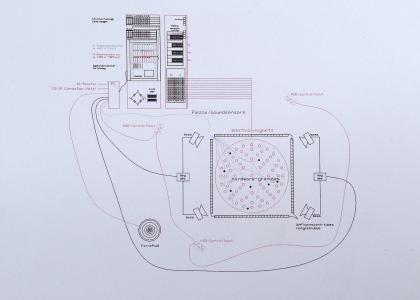Ritter/Zamet is pleased to present the first solo exhibition in the UK of Austrian artist, Herwig Weiser.
Since graduating from the School for Media Arts in Cologne in 1998, Herwig Weiser has exhibited in group exhibitions at venues including: V2_, Rotterdam, ZKM, Karlsruhe, Museum Ludwig, Cologne, IKON Gallery, Birmingham, Barbican Centre, London, CCAC Wattis Institute, San Francisco, ICA, London and most recently at the Kölnischer Kunstverein in Cologne. He has also received several awards including the Hermann Claasen Prize for Photography and Media Art in 1999 and the Nam June Paik Award in 2002.
Herwig Weiser’s complex, computer controlled constructions and room sized mechanisms may initially appear as high-tech utopian visions but essentially they are the antithesis of the rational, technocratic efficiency and banal materiality of the computer. Instead, they have more in common with the early mechano-kinetic investigations of Marcel Duchamp and Laszlo Moholy-Nagy or even the stacked TV sculptures of Nam June Paik. Weiser also adds a new and contemporary dimension to the classical nexus of art and technique by appropriating the industrial new media of his time to create fully functioning art-machines defined by their own inherent logic or purpose.
In the gallery-filling feat of engineering that is zgodlocator, these base materials include the reduced electronic components of the computer itself: crushed and granulated circuit boards, hard drives, processors, plug connectors etc. The purpose: to create a machine that restructures the basic magnetic principles of the computer’s hard disk to create instead a fluid, fully interactive synthesis of sound with the syntax of sculptural form and visual expression.
Within the raised platform structure, the magnetically sensitive computer-fragments are laid over super-charged electromagnetic grids beneath a circular, centrally illuminated panel. Attached joysticks allow the audience to manipulate the movement of the metallic particles over the magnets—shaping dynamic transformations of the materials into uncanny landscape-like abstractions. At the same time, contact microphones and sensors sample, synthesize and amplify the raw audio generated and convert it back into sound-patterns and shifting undulations in the surface landscape. Zgodlocator may well transform the computer into something reflective and ephemeral, yet its premise as a machine remains assuredly logical. It touches on the implicit human impulse to find meaning in the random and the nonsensical, safe in the knowledge that every action has an equal and opposite reaction.
Since graduating from the School for Media Arts in Cologne in 1998, Herwig Weiser has exhibited in group exhibitions at venues including: V2_, Rotterdam, ZKM, Karlsruhe, Museum Ludwig, Cologne, IKON Gallery, Birmingham, Barbican Centre, London, CCAC Wattis Institute, San Francisco, ICA, London and most recently at the Kölnischer Kunstverein in Cologne. He has also received several awards including the Hermann Claasen Prize for Photography and Media Art in 1999 and the Nam June Paik Award in 2002.
Herwig Weiser’s complex, computer controlled constructions and room sized mechanisms may initially appear as high-tech utopian visions but essentially they are the antithesis of the rational, technocratic efficiency and banal materiality of the computer. Instead, they have more in common with the early mechano-kinetic investigations of Marcel Duchamp and Laszlo Moholy-Nagy or even the stacked TV sculptures of Nam June Paik. Weiser also adds a new and contemporary dimension to the classical nexus of art and technique by appropriating the industrial new media of his time to create fully functioning art-machines defined by their own inherent logic or purpose.
In the gallery-filling feat of engineering that is zgodlocator, these base materials include the reduced electronic components of the computer itself: crushed and granulated circuit boards, hard drives, processors, plug connectors etc. The purpose: to create a machine that restructures the basic magnetic principles of the computer’s hard disk to create instead a fluid, fully interactive synthesis of sound with the syntax of sculptural form and visual expression.
Within the raised platform structure, the magnetically sensitive computer-fragments are laid over super-charged electromagnetic grids beneath a circular, centrally illuminated panel. Attached joysticks allow the audience to manipulate the movement of the metallic particles over the magnets—shaping dynamic transformations of the materials into uncanny landscape-like abstractions. At the same time, contact microphones and sensors sample, synthesize and amplify the raw audio generated and convert it back into sound-patterns and shifting undulations in the surface landscape. Zgodlocator may well transform the computer into something reflective and ephemeral, yet its premise as a machine remains assuredly logical. It touches on the implicit human impulse to find meaning in the random and the nonsensical, safe in the knowledge that every action has an equal and opposite reaction.
